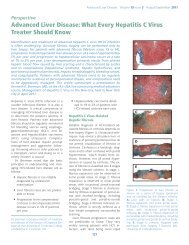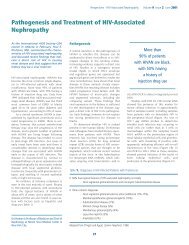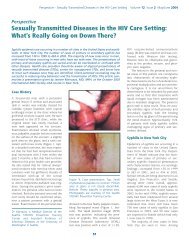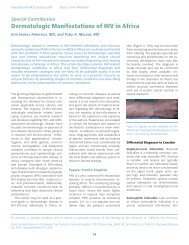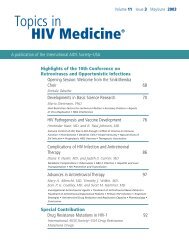The Potential Role of Therapeutic Drug Monitoring in the Treatment ...
The Potential Role of Therapeutic Drug Monitoring in the Treatment ...
The Potential Role of Therapeutic Drug Monitoring in the Treatment ...
- No tags were found...
You also want an ePaper? Increase the reach of your titles
YUMPU automatically turns print PDFs into web optimized ePapers that Google loves.
International AIDS Society–USA Topics <strong>in</strong> HIV Medic<strong>in</strong>elogic effect over an extended period <strong>of</strong> time does <strong>in</strong>deed occurfor both <strong>the</strong> protease <strong>in</strong>hibitors and <strong>the</strong> NNRTIs. If mutated andphenotypically less susceptible viral stra<strong>in</strong>s evolve dur<strong>in</strong>g <strong>the</strong>rapy,<strong>the</strong> pharmacologic effect is not constant over even a shortperiod <strong>of</strong> time. Higher concentrations <strong>of</strong> drugs may need to beachieved to control viral replication to <strong>the</strong> same extent as dur<strong>in</strong>g<strong>in</strong>itial <strong>the</strong>rapy.Based on <strong>the</strong>se pharmacologic criteria, <strong>the</strong> applicability <strong>of</strong>TDM to antiretroviral drugs is variable. S<strong>in</strong>ce treatment <strong>of</strong> HIV<strong>in</strong>fection requires <strong>the</strong> concomitant use <strong>of</strong> multiple drugs, monitor<strong>in</strong>gonly a s<strong>in</strong>gle drug (eg, a protease <strong>in</strong>hibitor or NNRTI)may not be appropriate. Both <strong>the</strong> <strong>the</strong>rapeutic efficacy and <strong>the</strong>toxicity <strong>of</strong> protease <strong>in</strong>hibitors and NNRTIs may demonstratesynergy, antagonism, or additive effects when comb<strong>in</strong>ed with<strong>the</strong> various nRTIs or each o<strong>the</strong>r. <strong>The</strong> presence <strong>of</strong> basel<strong>in</strong>e m<strong>in</strong>oritydrug-resistant mutations and <strong>the</strong> evolution <strong>of</strong> drug resistanceover time can make <strong>the</strong> concentration necessary forantiretroviral efficacy a mov<strong>in</strong>g target.Cl<strong>in</strong>ical CriteriaCl<strong>in</strong>ical studies exist that def<strong>in</strong>e <strong>the</strong> <strong>the</strong>rapeutic and toxic ranges <strong>of</strong> <strong>the</strong> drug.A <strong>the</strong>rapeutic range has not been formally def<strong>in</strong>ed for all drugs<strong>in</strong> cl<strong>in</strong>ical use for HIV, but concentration-response data areavailable for most <strong>of</strong> <strong>the</strong> protease <strong>in</strong>hibitors and NNRTIs. Oneproblem is <strong>the</strong> uncerta<strong>in</strong>ty as to which pharmacok<strong>in</strong>etic parameterbest def<strong>in</strong>es <strong>the</strong> <strong>the</strong>rapeutic and toxic exposures <strong>of</strong> <strong>the</strong>drugs. <strong>The</strong> C trough is usually monitored to determ<strong>in</strong>e adequatedrug exposure because it is <strong>the</strong> easiest to collect for both <strong>the</strong>patient and <strong>the</strong> <strong>in</strong>vestigator; however, this parameter requiresan accurate recall <strong>of</strong> when <strong>the</strong> last dose <strong>of</strong> <strong>the</strong> drug was adm<strong>in</strong>istered.Calculat<strong>in</strong>g an accurate area-under-<strong>the</strong>-curve valuewould require obta<strong>in</strong><strong>in</strong>g specimens over an extended period <strong>of</strong>time, which is unrealistic <strong>in</strong> a busy cl<strong>in</strong>ical sett<strong>in</strong>g. Logically,C trough should def<strong>in</strong>e <strong>the</strong> lowest drug concentration dur<strong>in</strong>g adosage <strong>in</strong>terval and thus def<strong>in</strong>e <strong>the</strong> m<strong>in</strong>imum effective concentration<strong>of</strong> <strong>the</strong> drug, but this has not been prospectively validatedfor any <strong>of</strong> <strong>the</strong> antiretroviral drugs.In terms <strong>of</strong> toxicity, <strong>the</strong> trough and <strong>the</strong> peak drug concentrationseach may play an important role. For example, C max maybest approximate <strong>the</strong> risk <strong>of</strong> <strong>in</strong>d<strong>in</strong>avir-<strong>in</strong>duced nephrotoxicity, 19but o<strong>the</strong>r toxicities such as sk<strong>in</strong> and nail abnormalities may berelated to total drug exposure. Marzol<strong>in</strong>i and colleaguesattempted to def<strong>in</strong>e <strong>the</strong> <strong>the</strong>rapeutic range <strong>of</strong> efavirenz by retrospectivelycorrelat<strong>in</strong>g CNS toxicity with plasma concentrations<strong>in</strong> a small group <strong>of</strong> subjects, some <strong>of</strong> whom were experienc<strong>in</strong>gvirologic failure. 7 Although this may be one way to def<strong>in</strong>e <strong>the</strong><strong>the</strong>rapeutic ranges for drugs, prospective studies that validate<strong>the</strong>se drug concentrations with observations <strong>of</strong> efficacy and toxicitywould certa<strong>in</strong>ly streng<strong>the</strong>n <strong>the</strong> argument for TDM.In drug-naive subjects, <strong>the</strong> C trough necessary for cont<strong>in</strong>uedviral suppression has been def<strong>in</strong>ed best for <strong>in</strong>d<strong>in</strong>avir. This concentrationis approximately 100 ng/mL, which is close to <strong>the</strong>prote<strong>in</strong>-b<strong>in</strong>d<strong>in</strong>g-corrected 95% <strong>in</strong>hibitory concentration for <strong>in</strong>d<strong>in</strong>avir<strong>in</strong> vitro. 16 However, <strong>the</strong> determ<strong>in</strong>ation <strong>of</strong> <strong>the</strong> C trough necessaryfor durable virologic suppression is made <strong>in</strong> <strong>the</strong> presence<strong>of</strong> concomitant nRTIs, and whe<strong>the</strong>r all <strong>of</strong> <strong>the</strong> nRTIs <strong>in</strong>teract with<strong>the</strong> protease <strong>in</strong>hibitors at <strong>the</strong> same potency <strong>in</strong> vivo has not beenstudied. Abacavir, for example, which is a much more potentantiretroviral drug than stavud<strong>in</strong>e, may quantitatively contributeto successful <strong>the</strong>rapy more than stavud<strong>in</strong>e when usedconcomitantly with protease <strong>in</strong>hibitors. 21,22Prospective Cl<strong>in</strong>ical Trials<strong>The</strong>re are only a few prospective studies that have exam<strong>in</strong>ed <strong>the</strong>utility <strong>of</strong> TDM <strong>in</strong> <strong>the</strong> treatment <strong>of</strong> HIV. ATHENA was a prospectivetrial <strong>of</strong> TDM <strong>in</strong> which analyses <strong>of</strong> a subgroup <strong>of</strong> patients on<strong>in</strong>d<strong>in</strong>avir or nelf<strong>in</strong>avir were performed. 23 N<strong>in</strong>ety-two treatmentnaivepatients were randomized to receive nelf<strong>in</strong>avir 1250 mgtwice daily us<strong>in</strong>g TDM or no TDM. A concentration ratio (CR)was used to assess drug exposure and make dos<strong>in</strong>g modifications<strong>in</strong> <strong>the</strong> TDM group. A measured drug level (drawn at anytime follow<strong>in</strong>g an unobserved dose) was compared with a populationaverage concentration-time curve. A ratio <strong>of</strong> 1 meant <strong>the</strong>patient’s concentration was <strong>the</strong> same as <strong>the</strong> population averageon that occasion. If <strong>the</strong> first nelf<strong>in</strong>avir CR was less than 0.9, tak<strong>in</strong>g<strong>the</strong> drug with food was discussed with <strong>the</strong> patient. If <strong>the</strong>subsequent CR rema<strong>in</strong>ed less than 0.9, <strong>the</strong> dose was <strong>in</strong>creasedto 1500 mg twice daily, and low-dose ritonavir was added if <strong>the</strong>third CR was low. <strong>The</strong> average turnaround time for <strong>the</strong> assayresults was 4 weeks.By <strong>in</strong>tent-to-treat (ITT) analysis, <strong>the</strong> proportions <strong>of</strong> patientsachiev<strong>in</strong>g plasma HIV-1 RNA levels below 500 copies/mL at 1year were 81% and 59% <strong>in</strong> <strong>the</strong> TDM and no-TDM groups, respectively(P=.03). <strong>The</strong> authors suggested that <strong>the</strong>se results reflecteddifferences <strong>in</strong> drug efficacy because <strong>the</strong> ma<strong>in</strong> reason for drugdiscont<strong>in</strong>uation <strong>in</strong> <strong>the</strong> no-TDM group was virologic failure,which was more frequent for <strong>the</strong> no-TDM group.<strong>The</strong> ATHENA study also exam<strong>in</strong>ed <strong>the</strong> effect <strong>of</strong> TDM <strong>in</strong> subjectsreceiv<strong>in</strong>g <strong>in</strong>d<strong>in</strong>avir 800 mg 3 times a day, <strong>in</strong>d<strong>in</strong>avir 800 mgwith 100 mg ritonavir twice daily, or <strong>in</strong>d<strong>in</strong>avir plus ritonavir at400 mg each twice daily. <strong>The</strong> acceptable CR for <strong>in</strong>d<strong>in</strong>avir wasdef<strong>in</strong>ed as 0.75 to 2.0. This analysis showed more favorable outcomes<strong>in</strong> <strong>the</strong> group randomized to TDM. By ITT analysis, 75%and 48% <strong>of</strong> subjects had plasma HIV-1 RNA levels below 500copies/mL <strong>in</strong> <strong>the</strong> TDM and no-TDM arms, respectively, at 1 year.This difference was secondary to toxicity, s<strong>in</strong>ce <strong>the</strong>re were veryfew virologic failures and far fewer subjects <strong>in</strong> <strong>the</strong> TDM armdropped out <strong>of</strong> <strong>the</strong> study for toxicity reasons than those <strong>in</strong> <strong>the</strong>no-TDM arm. <strong>The</strong>se data suggest that TDM may be potentiallyuseful <strong>in</strong> <strong>the</strong> management <strong>of</strong> antiretroviral <strong>the</strong>rapy for both efficacyand toxicity reasons. Although <strong>the</strong>se substudies <strong>of</strong> <strong>the</strong>ATHENA trial had positive results, concerns rema<strong>in</strong> regard<strong>in</strong>g<strong>the</strong> statistical power <strong>of</strong> <strong>the</strong> study to detect differences betweengroups and whe<strong>the</strong>r cl<strong>in</strong>icians truly followed dose change recommendations.PharmAdapt was a prospective study compar<strong>in</strong>g <strong>the</strong> use <strong>of</strong>TDM versus no TDM <strong>in</strong> treatment-experienced patients <strong>in</strong> whom<strong>the</strong>rapy failed. 24,25 A total <strong>of</strong> 257 subjects enrolled <strong>in</strong> this study,but <strong>the</strong> presented data were limited to 180 subjects receiv<strong>in</strong>gprotease <strong>in</strong>hibitor-conta<strong>in</strong><strong>in</strong>g regimens. N<strong>in</strong>ety-six subjectswere <strong>in</strong> <strong>the</strong> control group and 84 subjects were <strong>in</strong> <strong>the</strong> TDMgroup. All subjects had genotypic resistance test<strong>in</strong>g prior to randomization,and drug <strong>the</strong>rapy was determ<strong>in</strong>ed on <strong>the</strong> basis <strong>of</strong><strong>the</strong>se results. <strong>The</strong> TDM group had a dose modification at week8 based on week 4 trough concentrations. <strong>The</strong> targeted protease30




